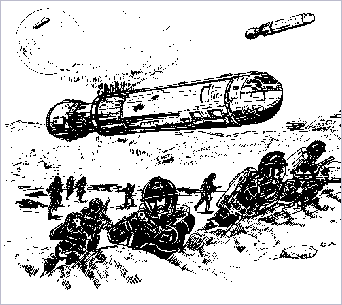|
In the course of the Third Frontier War (979 to 986) the Imperial armed forces developed a requirement for improvements in the standard assault boat for opposed planetary landings. The then current model had been developed in peacetime over 150 years previous, and the war was demonstrating some of its faults. Ling Standard Products developed the contract-winning design, and its Modular Cutter was put into production in 988 - too late for that war, but just in time for the next, the Solomani Rim War (990 to 1002). The LSP Mineral class Modular Cutter (now an IDP) is a single frame ship with modular inserts for use in a wide variety of tasks. Some were part of the original concept, while others were developed in the course of time for additional military or civilian uses. Each module is circular in cross-section, with a dorsal channel for the strut connecting the cutter’s bridge with its engine section. Modules are readily removed and replaced, and do not interfere with the ship’s streamlining. The modular cutter is essentially an alloy cylinder thirty meters in length and six meters in diameter. The nose is hemispherical and simple manufacturing techniques are used throughout. The widespread use of the LSP modular cutter by both Imperial and subsector armed forces has made a number of them available as surplus, and many are still found in service throughout the Imperium. Such units are occasionally found at prices (and qualities) as low as MCr2.5. Performance of the cutter is affected by its load. Normally accelerations of up to 4G can be achieved (with new or well-maintained manoeuvre drives). By operating the cutter without a module, the boat is reduced in weight; operating under such conditions, it can easily make 6G. Such use is not recommended however, as the single structural strut connecting the bridge and drives is not strong enough to withstand such abuse for long. |
| CraftID: | Modular Cutter, Type QT, TL 15, MCr17.06 |
| Hull: | 45/113, Disp=50, Config=1SL, Armor=40G, Unloaded=430tons, Loaded=850tons |
| Power: | 3/6, Fusion=700Mw, Duration=12 |
| Loco: | 5/10, M-Drive=4, No J-Drive, Vacuum=3,400kph, Top=1,000kph, Cruise=750kph, NOE=190kph, Agility=3 |
| Commo: | Radio=System |
| Sensors: | PassiveEMS=Interplanetary, ActiveEMS=Planetary, ActObjScan=Diff, ActObjPin=Diff, PasEngScan=Rout |
| Off/Def: | Hardpoint=1, DefDM=+7 |
| Control: | Computer=2 x3, Panel=HoloLink x76, Special=HUD |
| Environ: | BasicEnv, BasicLS, ExtendLS, GravPlates, InertialComp, Comfort=0.22 |
| Accomm: | Crew=2 (Bridge/Engineer=1, Command=1), Seat=Adequate x2 |
| SubCraft: | None |
| Other: | Cargo=405kliters, Fuel=100kliters, ObjSize=Small, EMLevel=Faint |
|
Modules
|
Picture by William H. Keith, Jr
